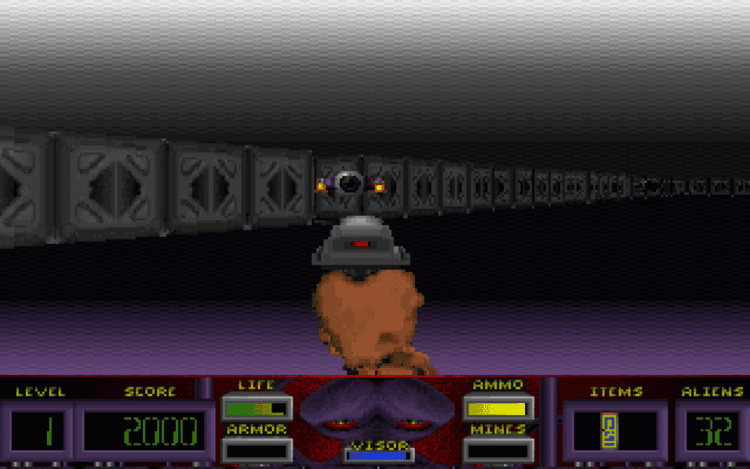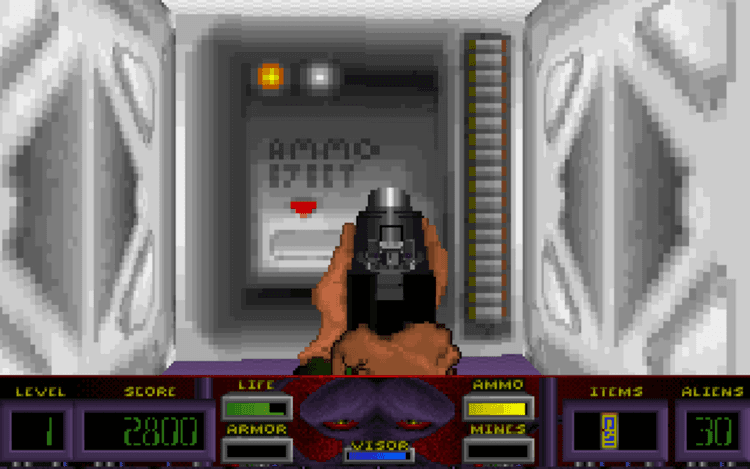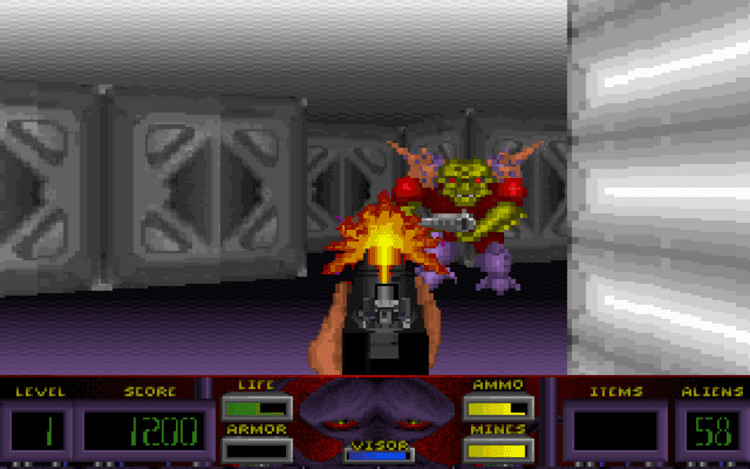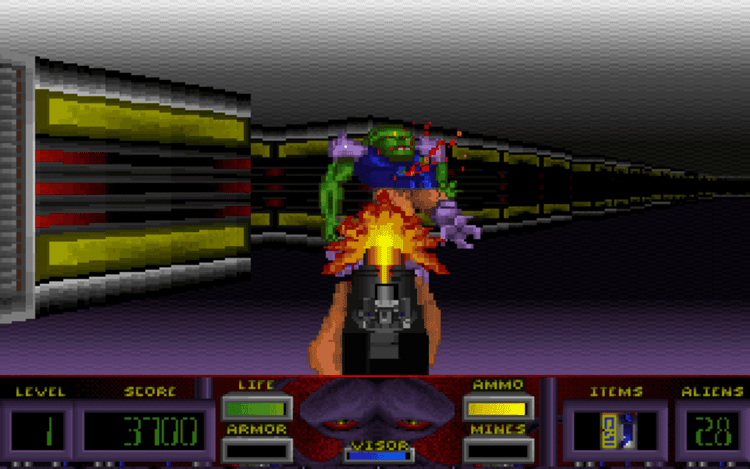
Corridor 7: Alien Invasion is a pulse-pounding first-person shooter forged by Capstone Software in the golden era of DOS. The game drops you inside a secret military complex where a teleport mishap unleashes vicious extraterrestrials. Fast, maze-like corridors recall the breakneck tension of Doom, while color-coded access keys echo the tactical structure of Wolfenstein 3D, yet the tight sci-fi focus gives Corridor 7 its own identity. Every encounter urges decisive movement and precision aiming, securing its legacy among early genre pioneers. Jump in now and play the game online for immediate retro adrenaline.
Launched during the booming shareware wave of the early 1990s, Corridor 7: Alien Invasion arrived from Capstone Software as the studio’s ambitious reply to the erupting first-person-shooter craze. Built on a modified Wolfenstein 3D engine, the game embraced science-fiction horror at a time when fantasy dungeons and demonic hellscapes dominated the market, offering players a sleek space-age alternative. Set within the labyrinthine corridors of a United States military research facility, the narrative revolves around an ill-fated attempt to open a gateway to Mars. Instead of riches and knowledge, the experiment pours hostile life-forms into the base, forcing a lone Special Forces operative—you—to seal the breach with bullets, wits, and a heap of futuristic gadgets. Decades later, the premise still sparks imagination, and the streamlined design keeps the experience approachable for newcomers who wish to play the game online or via classic hardware alike.
Capstone Software might not have enjoyed the mainstream recognition of id Software, yet the studio’s willingness to experiment granted Corridor 7 a personality that reaches beyond mere technological novelty. The development team tweaked the underlying engine to include richer lighting, dynamic alien noises, and a colorful heads-up display brimming with health readouts, radar pings, and weapon stats. Although texture variety remained limited by period constraints, vivid palette choices transformed sterile hallways into a sinister alien nest, bathing the player in harsh greens, midnight blues, and warning-light reds. Capstone’s love for cinematic flair surfaces in an animated introduction where static noise interrupts security feeds and claws streak across glass screens, foreshadowing chaos on the other side of the door. Such touches hint at a larger world without the need for sprawling cut-scenes, leaving space for the player’s imagination to blossom while they explore each level of the game.
Corridor 7 drenches every hallway in tension. Ventilation fans rattle, bio-hazard lights flicker, and a restless hum warns that an alien has slipped through the breach. A built-in motion tracker—an unmistakable nod to cinematic marine thrillers—keeps nerves on edge as dots swirl ever closer. The arsenal evolves from a modest pulse rifle to ion blasters, photon cannons, and a fearsome plasma flamethrower, each with distinctive sound and recoil that remains satisfying decades later. Opponents exploit the setting’s cramped geometry: invisible stalkers materialize at melee range, spider drones scurry beneath gunfire, and psychic warlords float silently until a prism-bright bolt erupts across the screen. Because ammunition and health are generous yet finite, every firefight becomes a study in resource management, encouraging route planning and daring retreat. Boss duels, meanwhile, match the spectacle found in Doom or Duke Nukem 3D, forcing players to weave between energy waves while unloading precious plasma cells.
One reason the title continues to thrive is its effortless adaptability to modern habits. Technology now allows fans to play Corridor 7: Alien Invasion online without wrestling with configuration files or disk images. Through browser-based emulation, the full campaign boots in seconds, giving instant access to every level, weapon, and eerie alien roar. Controls translate smoothly to modern keyboards, gamepads, and even touch screens, making mobile play surprisingly intuitive. Performance remains unrestricted; there are no timers on sessions, no paywalls mid-mission, and no region locks blocking late-night nostalgia runs. The straightforward interface of the original fits smaller phone displays perfectly, while desktop monitors highlight crisp pixel art that many retro shooters still imitate. Multiplayer deathmatch can even be enjoyed through virtual IP tunnels, letting friends relive sweaty rivalries from a shared online room. Frictionless accessibility preserves the game’s brisk pacing and vivid color design for future generations, proving that a strong core concept transcends hardware cycles.
The enduring charm of Corridor 7 lies in its momentum. Levels coil inward, guiding you toward the dimensional rift that anchors each episode. Keycards, secret rooms, and brisk enemy placements drive a tempo that modern shooters often abandon in favor of sprawling maps. Replay value blooms from a color-coded difficulty ladder that dares veterans to attempt “Psychotic” mode once they have mastered alien patrol routes. Short campaigns invite experimentation—speed-runs, pistol-only marathons, or map-wide hunts for hidden lore logs—while the industrial MIDI soundtrack layers clang and percussion to heighten urgency. In a landscape crowded with cinematic epics, Corridor 7’s concise, pick-up-and-play structure feels forever fresh, ideal for commuters, students on breaks, or anyone craving immediate retro energy.
Taken as a whole, Corridor 7: Alien Invasion remains a stellar illustration of how disciplined design and confident atmosphere can outlive technological boundaries. Its arsenal crackles with personality, its aliens drip menace, and its straightforward objectives ensure that both veterans and newcomers can jump into the action with minimal friction. Keyboard arrows (or modern WASD), the Ctrl key to fire, Alt to sidestep, and Space to operate doors still provide all the precision needed to dance around plasma blasts.
All game codes and assets referenced here are publicly available, and full ownership of the work remains with its original authors, whose creativity continues to inspire the wider shooter landscape.
Share game
Share game







Share game